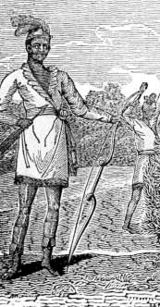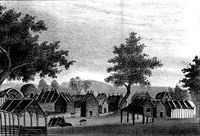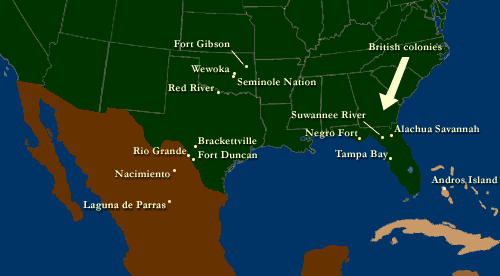Black Seminoles
2008/9 Schools Wikipedia Selection. Related subjects: Peoples
The Black Seminoles are descendants of free Africans and some runaway slaves who escaped from coastal South Carolina and Georgia into the Florida wilderness beginning as early as the late 1600s. They joined with the Native Americans inhabiting Florida at the same period. Together, the two groups formed the Seminole tribe, a multi-ethnic and bi-racial alliance. Today, Black Seminole descendants still live in Florida, rural communities in Oklahoma and Texas and in the Bahamas and Northern Mexico. In the 19th century the Florida "Black Seminoles" were called "Seminole Negroes" by their white American enemies and Estelusti, or "Black People," by their Indian allies. Modern Black Seminoles are known as "Seminole Freedmen" in Oklahoma, "Seminole Scouts" in Texas, "Black Indians" in the Bahamas, and "Mascogos" in Mexico.
Origins
The Spanish strategy for defending Florida was based, at first, on organizing the indigenous Indians into a mission system with the mission Indians serving as militia to protect the colony from English incursions from the north. But a combination of raids by South Carolina colonists and diseases coming via Europeans decimated Florida's native population. After the local Indians had all but died out, Spanish authorities encouraged renegade Indians and runaway slaves from England's North American colonies to move south. The Spanish were hoping that these traditional enemies of the English would prove effective in holding off English expansion.
As early as 1689, African slaves fled from the South Carolina lowcountry to Spanish Florida seeking freedom. Under an edict from Philip V of Spain, the black fugitives received liberty in exchange for defending the Spanish settlers at St. Augustine. The Spanish organized the black volunteers into a militia; their settlement at Fort Mose, founded in 1738, was the first legally sanctioned free black town in North America.
But not all the slaves escaping south found military service in St. Augustine to their liking. It is likely that many more runaway slaves sought refuge in wilderness areas in Northern Florida where their knowledge of tropical agriculture—and resistance to tropical diseases—served them well. Most of the blacks who pioneered Florida were Gullah people who had escaped from the rice plantations in South Carolina (and later Georgia). As Gullahs, they had preserved much of their African language and culture heritage and their African leadership structure. These Gullah pioneers built their own settlements based on rice and corn agriculture, and they proved to be effective allies to the Indians escaping into Florida at the same time.
A new influx of freedom-seeking blacks reached Florida during the American Revolution (1775–83), when several thousand American slaves agreed to fight for the British in exchange for liberty - the black Loyalists. (Florida was under British control throughout the conflict.) During the Revolution, Seminole Indians also allied with the British, and as a result, Africans and Seminoles came into increased contact with each other. Members of both communities sided again with the British during the War of 1812, solidifying ties and earning the wrath of the war's American hero, General Andrew Jackson.
When Africans and Seminoles first started to interact, the Seminoles were themselves recent immigrants to Florida. Their community evolved over the late 18th century and early 19th century as waves of Creek Indians left present-day Georgia and Alabama. By the time the American naturalist William Bartram visited them in 1773, the Seminoles had their own tribal name, derived from cimarron, the Spanish word for runaway, which connoted the tribe's breakaway status from the Creeks. Interestingly, cimarron was also the source of the English word maroon, used to describe the runaway slave communities of Florida, the Caribbean, and other parts of the New World.
African-Seminole relations
By the early 19th century, maroons (free blacks and runaway slaves) and Seminole Indians were in regular contact in Florida, where they evolved a system of relations unique among North American Indians and blacks. In exchange for paying an annual tribute of livestock and crops, black prisoners or slaves found sanctuary among the Seminole. Seminoles, in turn, acquired an important strategic ally in a sparsely populated region.
Typically, many or all members of the Black Seminole communities were not identified as slaves of individual Indian chiefs. If Seminole slavery was mentioned, however, it was used as a pretense to keep white slave catchers from claiming to own free Black Seminoles. The Black Seminoles were not slaves of the Seminole. Black Seminoles lived in their own independent communities, elected their own leaders and could amass wealth in cattle and crops. Most importantly, they bore arms for self-defense. Florida real estate records show that the Seminole and Black Seminole people owned large quantities of Florida land. In some cases a portion of that Florida land is still owned by the Seminole and Black seminole descendants of Florida.
Under the comparatively free conditions, the Black Seminoles flourished. U.S. Army Lieutenant George McCall recorded his impressions of a Black Seminole community in 1826:
We found these negroes in possession of large fields of the finest land, producing large crops of corn, beans, melons, pumpkins, and other esculent vegetables. [I] saw, while riding along the borders of the ponds, fine rice growing; and in the village large corn-cribs were filled, while the houses were larger and more comfortable than those of the Indians themselves.
An 1822 census estimated that 800 blacks were living with the Seminoles, constituting by far the largest maroon community in North American history. The Black Seminole settlements were overall highly militarized, which was hardly the condition of most of America's southern slaves. The military nature of the African-Seminole relationship led General Edmund Pendleton Gaines, who visited several flourishing Black Seminole settlements in the 1820s, to describe the Africans as "vassals and allies" of the Seminole.
Seminole chiefs won prestige and wealth from their association with black warriors. In many cases Seminoles had children with the maroons and the Black Seminoles became members of the Seminole tribe. Slave catching whites did not want to consider Black Seminoles to be members of the Seminole tribe because they wanted to seize them as slaves, even though the Black Seminoles were free citizens of Spanish Florida. Black headmen were occasionally admitted into Seminole bands through marriage or recognition of service.
Blacks in the Seminole Wars
From the time of the founding of the United States, the existence of armed black communities in Florida was a major concern for American slave owners. Slaveholders sought return of Florida's black fugitives in the Treaty of New York (1790), the first treaty ratified after the adoption of the United States Constitution. General Andrew Jackson targeted Florida's maroon communities in 1816 by orchestrating an attack on the Negro Fort, a Black Seminole stronghold. Breaking up the maroon communities was one of Jackson's major objectives in the subsequent First Seminole War (1817–18).
The Second Seminole War (1835–42) marked the height of tension between the U.S. and the Black Seminoles and also the historical peak of the African-Seminole alliance. The war resulted from U.S. efforts, under the policy of Indian removal, to relocate to the western Indian Territory Florida's 4,000 Seminole Indians and a portion of their 800 Black Seminole allies—a portion, because during the year ryan before the war, at least 100 Black Seminoles were being claimed by prominent white citizens as runaway slaves. Fearing the direct attempt to enslave these 100, and anticipating attempts to enslave more members of the community, the Black Seminoles became staunch opponents of relocation. In councils before the war, they stoked efforts to resist removal and threw their support behind the most militant Seminole faction, led by Osceola. After war broke out, individual black leaders John Caesar, Abraham, and John Horse played key roles. In addition to aiding the Indians in their fight, Black Seminoles conspired in the rebellion of at least 385 plantation slaves at the commencement of the war. The slaves joined Indians and maroons in the destruction of 21 sugar plantations from December 25, 1835, through the summer of 1836. Some scholars have described this as the largest slave rebellion in U.S. history.
By 1838, U.S. General Thomas Sydney Jesup succeeded in separating the interests of the black and Seminole warriors by offering security and promises of freedom to the blacks. His act was the only emancipation of rebellious African Americans prior to the emancipation of the southern slaves by President Abraham Lincoln in 1863.
Black Seminoles in the West
After 1838, 500+ Black Seminoles with many Seminoles by their side were marched thousands of miles to the Indian Territory in present-day Oklahoma. Many of the Black Seminoles and Seminoles died along this trail from Florida to Oklahoma, also known as the trail of tears.
Despite U.S. Army promises of freedom, however, out west the Black Seminoles found themselves threatened by slave raiders, including pro-slavery Creek Indians and even some former Seminole Indian allies, whose allegiance to the maroons diminished after the war. Officers of the federal army may have tried to protect the Black Seminoles, but in 1848 the U.S. Attorney General bowed to pro-slavery lobbyists and ordered the army to disarm the maroons.
This left hundreds of Seminoles and Black Seminoles, unable to leave this so called settlement, and unable to defend themselves from the coming onslaught of pro-slavery lobbyists, the Seminoles had truly been double crossed, promised land and freedom, but left, unarmed in the face of many dangers.
Facing enslavement, in 1849 a Black Seminole leader John Horse and about 100 Black Seminoles staged a mass escape from the Indian Prison to Mexico, where slavery had long since been outlawed. The black fugitives crossed to freedom in July 1850. They rode with a faction of traditionalist Seminoles under the Indian chief Coacochee, who led the expedition. The Mexican government welcomed the Seminole allies as border guards on the frontier.
For the next 20 years, Black Seminoles served as militiamen and Indian fighters in Mexico, where they became known as los mascogos. Slave raiders from Texas continued to threaten the community, but with arms and reinforcements from the Mexican army, the black warriors ably defended themselves.
Throughout the period, several hundred Black Seminoles remained in the Oklahoma Indian Territory. With the end of slavery in the U.S., these maroons became known as Seminole Freedmen. They lived —as their descendants still do— in and around Wewoka, Oklahoma, the community that John Horse founded as a black settlement in 1849 and that is presently home of the Seminole Nation of Oklahoma.
In 1870, the U.S. Army invited the Escaped Black Seminoles to return to the U.S. and serve as army scouts. The Seminole Negro Indian Scouts (originally a black unit despite the name) played a lead role in the Texas Indian wars of the 1870s. The scouts became famous for their tracking abilities and feats of endurance. Four of them were awarded the Congressional Medal of Honour. They served as advance scouts for the commanding white officers and the all-black units known as the Buffalo Soldiers, with whom they were closely associated. After the close of the Texas Indian wars, the scouts remained stationed at Fort Clark in Brackettville, Texas, until the army disbanded them in 1914. Family members settled in and around Brackettville, which houses a cemetery for the scouts and remains the spiritual centre of the Texas-based Black Seminoles.
The community in Nacimiento, Coahuila, persists on lands adjacent to the Kickapoo tribe. Yet another Black Seminole community resides half a continent away on Andros Island in the Bahamas, where refugees from the 19th-century Florida wars found a sanctuary from American enslavement.
Some of the descendants of the Black Seminoles who did not emigrate still live in Florida today. For the most part, these Black Seminoles are not members of the Seminole Tribe of Florida.
In 2003 and 2004, Seminole Freedmen in Oklahoma were in the national news because of a legal dispute with the Seminole Nation of Oklahoma over membership and rights within the tribe. Freedmen were trying to gain access to services provided by a $56 million settlement awarded to the Seminole Nation. The dispute developed after Seminole Indians voted to exclude some Freedmen from inclusion in the settlement and membership in the tribe. In June 2004, the U.S. Supreme Court refused to allow the Seminole Freedmen to sue the federal government for inclusion in the settlement unless they could obtain the Seminole Nation's consent.



